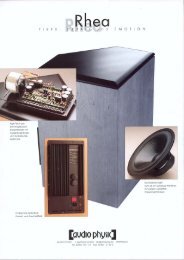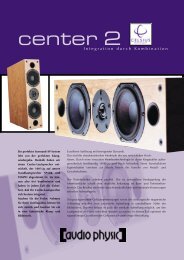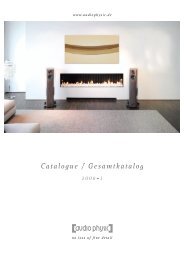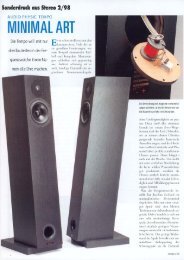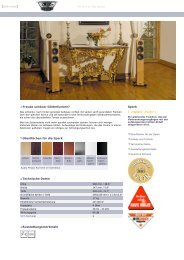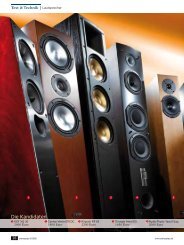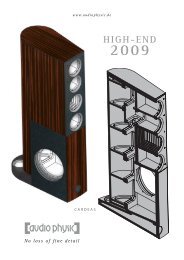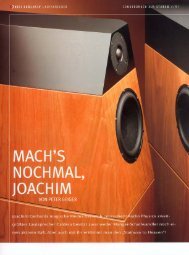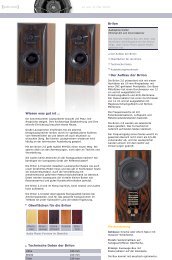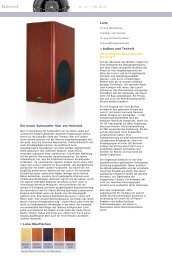32 Test Lautsprecher Audio Physic Scorpio 25
32 Test Lautsprecher Audio Physic Scorpio 25
32 Test Lautsprecher Audio Physic Scorpio 25
Create successful ePaper yourself
Turn your PDF publications into a flip-book with our unique Google optimized e-Paper software.
<strong>32</strong> <strong>Test</strong> <strong>Lautsprecher</strong> <strong>Audio</strong> <strong>Physic</strong> <strong>Scorpio</strong> <strong>25</strong><br />
Nr_3-2011
Technik mit<br />
Leidenschaft<br />
Auf der Webseite grinst mich formatfüllend eine „<strong>25</strong>“ an. <strong>25</strong> Jahre <strong>Audio</strong><br />
<strong>Physic</strong> – das will gefeiert werden. Die Briloner tun dies in Form verfeinerter<br />
Aufl agen ihrer Erfolgsmodelle. Diesen Adel erhält nun auch die <strong>Scorpio</strong>, die<br />
ihre Weltpremiere in unserem Hörraum feiert<br />
Alle waren sie schon dran. Die Tempo.<br />
Die Virgo. Die Avanti. Das Flaggschiff<br />
Cardeas sowieso. Nur der <strong>Scorpio</strong> fehlte er<br />
noch. Er, den ich auf den ersten Blick für<br />
eine kleine Hochtonkalotte mit Schallführung<br />
hielt. Doch <strong>Audio</strong>-<strong>Physic</strong>-Entwickler<br />
Manfred Diestertich klärt schnell auf: Es<br />
ist ein Konushochtöner. Wie jetzt? Ein Konus<br />
im Hochton, in der gesamten Mittelund<br />
Spitzenklasse bis hinauf zur Referenz?<br />
Wenn Sie ab und an auch mal in unsere<br />
KLANG+TON schauen, wissen Sie, dass<br />
wir den wenigen überlebenden Hochtonkonussen<br />
durchaus zugeneigt sind. Dass<br />
ich die vermeintlich ausgestorbene Technik<br />
aber in einer frisch überarbeiteten Jubiläums-Standbox<br />
für 5.000 Euro antreffen<br />
würde, hätte ich nicht erwartet.<br />
Selbstverständlich setzt <strong>Audio</strong> <strong>Physic</strong> nicht<br />
auf ein Modell von der Stange, sondern<br />
lässt sich den eigens entwickelten Konus<br />
nach engen Vorgaben von seinem Chassiszulieferer<br />
bauen. Mit den bekannten Billigkonussen<br />
und ihrem charakteristischen<br />
Eigenklang hat der Hyper-Holographic-<br />
Cone-Hochtöner II, kurz HHCT II, daher<br />
wenig gemein. Vielmehr setzt er dort an, wo<br />
übliche Kalotten schwächeln: kontrollierte<br />
Membranbewegungen. Zwar haben die<br />
Hersteller die Technik dank vielen Jahren<br />
Erfahrung sehr gut im Griff, das ändert am<br />
generellen Prinzip aber nichts: Eine weiche<br />
Gewebemembran folgt ihrer Schwingspule<br />
ab Frequenz x nicht mehr kolbenförmig,<br />
sondern bricht in Teilschwingungen auf.<br />
Dass damit eine Portion Eigenklang zum<br />
eigentlichen Musiksignal addiert wird,<br />
liegt auf der Hand.<br />
Um dieses Problem zu umgehen, setzt <strong>Audio</strong><br />
<strong>Physic</strong> auf einen knapp 40 mm durchmessenden<br />
Konus mit einer praktisch<br />
nicht zur Schallabstrahlung beitragenden<br />
Gewebedustcap. Außen sorgt ein breiter<br />
Schaumstoffring für defi nierte Dämpfung.<br />
Nach hinten ist der Konus offen, daher be-<br />
sitzt der Tweeter in der <strong>Scorpio</strong> seine eigene<br />
kleine Kammer, die ihn vor Tiefton-Druckwellen<br />
schützt. Manfred Diestertich fi ndet<br />
durchaus markige Worte zum HHCT II:<br />
„Wenn du dich einmal auf den eingehört<br />
hast, kommst du mit Kalotten nicht mehr<br />
wirklich klar.“ Ich bin gespannt ...<br />
Angesichts der weiteren Technik der <strong>Scorpio</strong><br />
<strong>25</strong> wird allerdings schnell deutlich, dass<br />
dem Herrn nichts ferner läge als überzogene<br />
Prahlerei. Der Ideenreichtum endet<br />
nämlich keineswegs hinter dem Hochtöner.<br />
In den beiden 15-cm-Mitteltönern<br />
der <strong>Scorpio</strong> <strong>25</strong>, passenderweise HHCM<br />
genannt, steckt nämlich mindestens genauso<br />
viel Hirnschmalz wie im Hochtonkonus.<br />
Der doppelte <strong>Lautsprecher</strong>korb<br />
aus Aludruckguss und Kunststoff ist so<br />
ein Kandidat. Außen sorgt Aluminium<br />
für Steifi gkeit und Kühlung des potenten<br />
Neodymmagneten, innen entkoppelt<br />
ein zweiter Kunststoffkorb das Schwingsystem<br />
vom <strong>Lautsprecher</strong>gehäuse. Die als<br />
sehr präzise klingenden, aber resonanzbehaftet<br />
bekannten Aluminiummembranen<br />
hat <strong>Audio</strong> <strong>Physic</strong> über einen elastischen<br />
Ring am Membranrand fest im Griff. Das<br />
Silikon spannt den Konus mechanisch vor<br />
und bedämpft das Klingeln des Metalls<br />
sehr effektiv.<br />
Auch die vier 17-cm-Tieftöner setzen auf<br />
den harten Werkstoff zur Schallerzeugung.<br />
Sie sitzen sich am unteren Ende des Gehäuses<br />
paarweise gegenüber und negieren<br />
ihr Bewegungsmoment auf das Gehäuse<br />
gegenseitig. Dank perfekt ausgelegter Parameter<br />
gibt sich das Quartett im ventilierten<br />
Gehäuse so volumengenügsam, dass die<br />
<strong>Scorpio</strong> <strong>25</strong> größenmäßig nicht ausartet.<br />
Im Gegenteil, kommt sie mit ihrer schlanken<br />
Silhouette, den geschwungenen Sei-<br />
<strong>Lautsprecher</strong> <strong>Test</strong> 33<br />
Mitspieler<br />
Seitenbässe ermöglichen die schlanke Silhouette der<br />
<strong>Scorpio</strong> <strong>25</strong>, eine tiefe Trennfrequenz zu den potenten<br />
Mitteltönern hält die Raumabbildung sauber<br />
Plattenspieler:<br />
· Acoustic Solid Machine mit SME<br />
M2-12 und Clearaudio Goldfi nger<br />
Phono-Vorverstärker:<br />
· Malvalve preamp three phono<br />
Vorverstärker:<br />
· Malvalve preamp three line<br />
Endverstärker:<br />
· KLANG+TON SymAsym<br />
Zubehör:<br />
· Netzleiste: PS-<strong>Audio</strong><br />
· Stromkabel: Silent Wire<br />
· NF-Kabel: Silent Wire<br />
· Phonokabel: Van den Hul<br />
· <strong>Lautsprecher</strong>kabel: Intertechnik<br />
· Racks: Copulare<br />
· Plattenwaschmaschine: Clearaudio<br />
Gegenspieler<br />
· Isophon Cassiano<br />
· B&W 800 Diamond<br />
· Ascendo C8<br />
Nr_3-2011
34 <strong>Test</strong> <strong>Lautsprecher</strong> <strong>Audio</strong> <strong>Physic</strong> <strong>Scorpio</strong> <strong>25</strong><br />
Air – Moon Safari<br />
Gespieltes<br />
Air<br />
Moon Safari<br />
Björk<br />
Homogenic<br />
Kraftwerk<br />
Minimum-Maximum<br />
Aglaja Camphausen<br />
und die Schmonzetten<br />
Alone<br />
Kari Bremnes<br />
Ly<br />
tenwänden und der nach hinten geneigten<br />
Form doch sehr elegant und stimmig rüber.<br />
Mit den zahlreichen Furniervarianten<br />
und den Klassikern Hochglanzschwarz und<br />
-weiß ist die <strong>Scorpio</strong> <strong>25</strong> ohne Probleme in<br />
jede Wohnwelt zu integrieren und darf<br />
nicht nur angesichts der attraktiven Form,<br />
sondern auch der absolut exzellenten Verarbeitungsqualität<br />
gerne gezeigt werden.<br />
Im Inneren der Box geht es weiter mit den<br />
cleveren Ideen. Dass das Gehäuse an diversen<br />
Stellen versteift ist, kann man noch<br />
unter Routine verbuchen. Interessant wird<br />
es bei der Beschichtung des Mitteltongehäuses<br />
mit überkreuzten Holzstäben. Sie<br />
vergrößern die Oberfl äche der Innenwände,<br />
vermindern Refl exionen und machen<br />
einen gesunden Anteil schallschluckendes<br />
Dämmmaterial überfl üssig. Die solide<br />
Alukonstruktion rund um die WBT-Terminals<br />
auf der Rückseite ist vom Gehäuse<br />
entkoppelt. Die metallenen Füße der Box<br />
besitzen ihren eigenen Entkopplungsmechanismus,<br />
sind im Übrigen auch separat<br />
als Gehäusefüße erhältlich und entkoppeln<br />
die <strong>Scorpio</strong> <strong>25</strong> defi niert vom Boden. Die<br />
Mittelhochton-Frequenzweiche, ebenfalls<br />
per Aufhängung entkoppelt, besitzt eine<br />
inzwischen viel diskutierte Bauteileanordnung,<br />
der wir uns in der KLANG+TON<br />
noch widmen werden. Durch das Aufsplitten<br />
oder Umsortieren der Bauteile wird das<br />
<strong>Lautsprecher</strong>chassis von der Masseleitung<br />
entkoppelt – elektrisch und messtechnisch<br />
irrelevant, soll sich klanglich ein deutlich<br />
hörbarer Unterschied einstellen. Experimentierfreudig<br />
sind wir, neugierig sowieso,<br />
also prüfen wir das in Kürze mal nach.<br />
Sie merken, ich stopfe. Mit allen technischen<br />
Details dieser Box könnte man<br />
wohl ein Buch füllen. Ich hingegen fasse<br />
mich inzwischen kurz, denn ich versuche,<br />
so viel Platz wie möglich für die Klangbeschreibung<br />
zu retten. Warum? Ganz einfach:<br />
Weil die <strong>Scorpio</strong> <strong>25</strong> grandios klingt.<br />
Ich dachte angesichts der Messung eingangs<br />
an einen eher hellen Klangcharakter,<br />
dem ist aber nicht so. Vielmehr<br />
wirkt die Box beim ersten Höreindruck<br />
neutral bis minimal dunkel. Aber das<br />
täuscht, denn was der Hochtöner tatsächlich<br />
nicht besitzt, ist Eigenklang.<br />
Das Gehäuse der <strong>Scorpio</strong> <strong>25</strong> ist nicht<br />
nur aus optischen Gründen nach<br />
hinten geneigt: der Winkel verbessert<br />
das Zeitverhalten und neigt die<br />
Hauptabstrahlachse nach oben<br />
Keine Spielereien: ein<br />
hochsolides, vom Gehäuse<br />
entkoppeltes Terminal<br />
mit WBT-Klemmen und<br />
ein strömungsgünstig<br />
geformtes Reflexrohr.<br />
Ein zweites Rohr sitzt<br />
im Boden der Box<br />
<strong>Audio</strong> <strong>Physic</strong> <strong>Scorpio</strong> <strong>25</strong><br />
· Preis 5.000 Euro pro Paar<br />
· Vertrieb <strong>Audio</strong> <strong>Physic</strong>, Brilon<br />
· Telefon 02961 96170<br />
· Internet www.audiophysic.de<br />
· Gewicht 27 kg<br />
· Garantie 10 Jahre<br />
· Chassis 4 x 180-mm-Tieftöner<br />
2 x 150-mm-Mitteltöner<br />
1 x 39-mm-Konushochtöner<br />
· B x H x T 214 x 1100 x 390 mm<br />
Unterm Strich …<br />
» ... <strong>Audio</strong> <strong>Physic</strong>s <strong>Scorpio</strong> <strong>25</strong> ist ein hervorragender<br />
Schallwandler. Alle Details sind<br />
technisch perfekt und vollkommen schnickschnackfrei<br />
gelöst. Sie sieht gut aus, ist elegant,<br />
schlank, sehr wohnraumtauglich. Sie besitzt ein<br />
exzellent in sich geschlossenes, äußerst stimmiges,<br />
energetisch ausgewogenes Klangbild<br />
höchster Präzision in allen Frequenzbereichen.<br />
Und doch schafft sie den Spagat,<br />
nicht technisch unterkühlt, sondern<br />
unglaublich locker, dynamisch und<br />
emotional zu klingen.<br />
Nr_3-2011
Gemessenes<br />
Messtechnik-Kommentar<br />
Die <strong>Scorpio</strong> <strong>25</strong> gibt sich vor dem Mikrofon<br />
leicht badewannig mit um 70 Hz betontem,<br />
aber langsam fallendem Bass, zurückgenommenem<br />
Mittelton und unter 15 Grad perfekt<br />
linearem Hochton. Der Anstieg nach oben<br />
täuscht optisch, da er erst ab 20 kHz stattfindet<br />
und nicht mehr hörbar ist. Die Impedanz<br />
schwankt oberhalb des Bassbereichs nur um<br />
wenige Ohm und liegt sauber in der 4-Ohm-<br />
Norm. Der Klirr ist auch bei hohen Pegeln sehr<br />
gering, das Ausschwingverhalten bis auf eine<br />
mimimale Resonanz des Hochtöners sehr sauber<br />
und schnell<br />
Für ein Dreieinhalb-Wege-System bleiben<br />
die in Basssektion und Mittelhochton getrennten<br />
Weichen übersichtlich. Letztere ist<br />
zusätzlich von ihrer Trägerplatte entkoppelt<br />
Traumtrio: der extrem präzise und dynamisch aufspielende<br />
Konustweeter, der perfekt bedämpfte<br />
Alumembran-Mitteltöner und der potente Woofer<br />
Er folgt dem Musiksignal äußerst<br />
präzise und kontrolliert, besitzt dabei<br />
aber eine dermaßen unspektakulär-beiläufi<br />
ge Note, dass alle anderen<br />
Tweeter irgendwie effekthascherisch<br />
wirken. Wer den berühmten Manger-<br />
Wandler im Ohr hat, weiß, was ich<br />
meine: kein Zisch und Pling, einfach<br />
nur Klang in seiner reinsten Form.<br />
Dabei buhlen die Mitspieler des<br />
Hochtonwunders durchaus um eigene<br />
Aufmerksamkeit. Der druckvolle<br />
Bassbereich ist für vier Siebzehner<br />
überaus stabil, stämmig, perfekt konturiert<br />
und löst Feinheiten ebenfalls<br />
hervorragend auf. Zwischendurch<br />
war ich ob der extremen Pegel, die<br />
ich angesichts der Verzerrungsarmut<br />
der Box erreicht hatte, um das<br />
Überleben der Bässe besorgt. Der<br />
Blick hinter die Bespannung verriet<br />
mir aber, dass hier üppige Reserven<br />
schlummern.<br />
Der Grundton ist ebenfalls exzellent<br />
sauber und fast erschreckend durchhörbar.<br />
Stimmen stellt die <strong>Scorpio</strong><br />
<strong>25</strong> klar umrissen und perfekt positioniert<br />
in den Raum. Vor allem bei<br />
den Damen der Sangeswelt wird die<br />
Klasse des Hochtöners deutlich. Ich<br />
habe mich im Hörraum mit Björk<br />
& Co. bei abartigen Pegeln gefönt,<br />
und das genau aus einem Grund: Es<br />
macht unglaublichen Spaß, mit welcher<br />
Sauberkeit und Dynamik die<br />
<strong>Audio</strong> <strong>Physic</strong> eine Frauenstimme mit<br />
extremer Lautstärke in den Raum<br />
stellt. Dass eine Kalotte mit so etwas<br />
ein Problem hat, war mir zumindest<br />
in diesem Maße nicht bewusst.<br />
Kollegen ziehen mich immer damit<br />
auf, ich wäre ein Lautstärke-Weichei.<br />
Quatsch! Wenn die Box es hergibt,<br />
dann höre ich auch mit Vergnügen<br />
laut. Leider kombiniert kaum ein<br />
<strong>Lautsprecher</strong> eine perfekt ausbalancierte<br />
Energieverteilung mit hoher<br />
Pegelfestigkeit. Doch einer tut‘s: die<br />
<strong>Scorpio</strong> <strong>25</strong>.<br />
Christian Gather<br />
�������� �� ��� ������������ �������<br />
��� ��������� � ��������������� ���<br />
���� ���� ����� ����� ���� ����������<br />
����� �������������������� ��� ��� �����<br />
���� ��������������� ��� �� ������ �������<br />
����������� ���������� ������������� �����<br />
��� ���� ���������� ����������� ��������<br />
��� ��� ������� �������������<br />
����������� ��<br />
��������������������<br />
���� ���<br />
�� ��� �<br />
� � � ������� � ����� � ������ � � �
<strong>32</strong> <strong>Test</strong> <strong>Audio</strong> <strong>Physic</strong> <strong>Scorpio</strong> <strong>25</strong> Loudspeaker<br />
Nr_3-2011
Technology<br />
with Passion<br />
I am welcomed to the website by a huge “<strong>25</strong>”, happily �lling the entire screen.<br />
Indeed, <strong>25</strong> years of <strong>Audio</strong> <strong>Physic</strong> is certainly a cause for celebration and the com-<br />
pany from Brilon, Germany, is doing so by producing improved special editions<br />
of its most successful models. The latest model to undergo this special treatment<br />
is the <strong>Scorpio</strong>, which celebrated its world premiere in our listening room.<br />
T hey<br />
have all had their turn. The Tempo,<br />
the Virgo, the Avanti and, of course, the<br />
company’s flagship: the Cardeas. Only the<br />
<strong>Scorpio</strong> was still waiting for its moment; the<br />
loudspeaker that I considered to be<br />
equipped with a small dome tweeter with<br />
sound conduction at first glance. I was,<br />
however, rapidly corrected by Manfred<br />
Diestertich, who declared that the <strong>Scorpio</strong><br />
has a cone tweeter. A what? A cone in the<br />
tweeter, in the entire medium and top class<br />
and right through to the reference class? If<br />
you browse through our magazine “KLANG<br />
+ TON” now and again, you will know that we<br />
are indeed inclined towards the few tweeter<br />
cones that have survived into the present<br />
day. Nevertheless, I never would have<br />
thought that I would see such technology,<br />
which is assumed to be extinct, in a freshly<br />
revamped anniversary model of a<br />
floor-standing loudspeaker for 5000 Euros.<br />
Of course, <strong>Audio</strong> <strong>Physic</strong> does not<br />
rely on a run-of-the-mill product but has<br />
instead commissioned its driver supplier to<br />
follow strict specifications and produce a<br />
cone developed by <strong>Audio</strong> <strong>Physic</strong> itself. The<br />
Hyper Holographic Cone Tweeter II, or<br />
HHCT II for short, therefore has little in<br />
common with the well-known cheap cones<br />
and their characteristic sound. In fact, the<br />
HHCT II works its magic exactly where<br />
common domes falter, namely where<br />
controlled diaphragm movements are<br />
concerned. The manufacturers do indeed<br />
have an excellent grasp of this technology<br />
thanks to their many years of experience, but<br />
this does not change anything about the<br />
general principle: a soft fabric diaphragm<br />
that no longer follows its voice coil in a piston<br />
shape at frequencies above x but instead<br />
opens out in partial vibrations. The fact that it<br />
therefore adds its own sound to the actual<br />
musical signal is an obvious consequence.<br />
In order to avoid this problem,<br />
<strong>Audio</strong> <strong>Physic</strong> relies on a cone with a<br />
diameter of close to 40mm (1.5”) and with a<br />
practical fabric dustcap that does not<br />
contribute to the radiation of sound. The<br />
exterior contains a wide foam ring that<br />
ensures defined damping. The cone is open<br />
at the back, which is why the tweeter has<br />
been given its own small chamber in the<br />
<strong>Scorpio</strong> in order to protect it against pressure<br />
waves from the woofer. When describing<br />
the HHCT II, Manfred Diestertich certainly<br />
doesn’t hold back on his words, stating that:<br />
“Once you’ve gotten used to it, your friendship<br />
with domes will suffer considerably.” I’m<br />
excited to try it out for myself…<br />
Where the other technology used<br />
in the <strong>Scorpio</strong> <strong>25</strong> is concerned, it soon becomes<br />
clear that Diestertich is by no means<br />
excessively boasting about his product. The<br />
abundance of ideas certainly does not end<br />
at the tweeter but runs throughout the<br />
loudspeaker, for example in its two 15cm<br />
(6’’) midrange drivers. These drivers, which<br />
are fittingly called the HHCMs, involve at<br />
least just as much brain power as the<br />
tweeter cone. The double loudspeaker<br />
basket made of die-cast aluminium and<br />
plastic is a prime example, with the external<br />
aluminium guaranteeing rigidity and cooling<br />
the powerful neodymium magnet while a<br />
second plastic basket on the inside decouples<br />
the moving system from the loudspeaker<br />
cabinet. In order to keep the aluminium<br />
diaphragm, which produces a very precise<br />
sound but is also known to be afflicted with<br />
resonance, under control, <strong>Audio</strong> <strong>Physic</strong><br />
uses an elastic ring fitted around the edge of<br />
the diaphragm. The silicon ring mechanically<br />
tightens the cone and extremely effectively<br />
damps the ringing of the metal.<br />
The four 17cm (7’’) woofers also<br />
rely on this hard material for their sound<br />
production. These drivers are placed opposite<br />
each other in pairs at the base of the<br />
cabinet and cancel out each others vibrations<br />
transmitted to the cabinet. Thanks to its<br />
perfectly designed parameters, the quartet<br />
of woofers in the ventilated cabinet takes up<br />
so little room that the <strong>Scorpio</strong> <strong>25</strong> does not<br />
get out of hand in terms of size. Indeed, the<br />
opposite applies and the loudspeaker has<br />
an extremely elegant and harmonious<br />
appearance due to its slim silhouette, lightly<br />
curved sides and slanted shape.<br />
Loudspeaker<br />
Protagonists<br />
<strong>Test</strong><br />
Turntable:<br />
· Acoustic Solid Machine with SME<br />
M2-12 and Clearaudio Goldfi nger<br />
Phono-preampli�er:<br />
· Malvalve preamp three phono<br />
Preampli�er:<br />
· Malvalve preamp three line<br />
Ampli�er:<br />
· KLANG+TON SymAsym<br />
Nr_3-2011<br />
33<br />
Accessories:<br />
· Power bar: PS-<strong>Audio</strong><br />
· Power cord: Silent Wire<br />
· Low frequency cable: Silent Wire<br />
· Phonokabel: Van den Hul<br />
· Phono cable: Intertechnik<br />
· Racks: Copulare<br />
· Record cleaning machine : Clearaudio<br />
Antagonists<br />
Side-mounted woofers allow the <strong>Scorpio</strong> <strong>25</strong> to have a slim<br />
silhouette, while a low crossover frequency to the powerful<br />
midrange drivers ensures clear spatial imaging<br />
· Isophon Cassiano<br />
· B&W 800 Diamond<br />
· Ascendo C8
34 <strong>Test</strong> <strong>Audio</strong> <strong>Physic</strong> <strong>Scorpio</strong> <strong>25</strong> Loudspeaker<br />
Air – Moon Safari<br />
Music Played<br />
Air<br />
Moon Safari<br />
Björk<br />
Homogenic<br />
Kraftwerk<br />
Minimum-Maximum<br />
Aglaja Camphausen<br />
und die Schmonzetten<br />
Alone<br />
Kari Bremnes<br />
Ly<br />
With its wide range of different veneers,<br />
including the classic black or white high gloss<br />
veneers, the <strong>Scorpio</strong> <strong>25</strong> can be easily integrated<br />
into every living space and deserves to be<br />
proudly displayed, not only due to its attractive<br />
shape, but also because of its absolutely<br />
fantastic high-quality finish.<br />
The clever ideas continue inside the<br />
loudspeaker. The fact that the cabinet is<br />
reinforced in a variety of places can be seen as<br />
routine, but the intersecting wooden rods that<br />
cover the walls of the midrange driver chambers<br />
is where things start to get interesting.<br />
These rods increase the surface area of the<br />
interior walls, reduce reflections and make a<br />
hefty amount of sound-absorbing damping<br />
material superfluous. The solid aluminium<br />
construction surrounding the WBT terminals at<br />
the back of the loudspeaker is decoupled from<br />
the cabinet. The loudspeaker’s metal feet have<br />
their own decoupling mechanism and are<br />
incidentally also available separately in the<br />
form of cabinet feet that clearly decouple the<br />
<strong>Scorpio</strong> <strong>25</strong> from the floor. The midrange crossover<br />
network, which is also decoupled by<br />
means of suspension, contains an arrangement<br />
of components that has become a major<br />
topic of discussion and on which we will focus<br />
in an issue of our KLANG + TON magazine. By<br />
splitting up or re-sorting the components,<br />
<strong>Audio</strong> <strong>Physic</strong> has decoupled the loudspeaker<br />
driver from the earth cable, which is irrelevant<br />
in terms of electrics or measurement<br />
techniques but apparently causes a difference<br />
in sound that can be clearly heard. We do love<br />
to experiment and are indeed very inquisitive,<br />
so will check this out shortly.<br />
As you can tell, I’m coming to a halt.<br />
The thing is, you could fill an entire book with<br />
all of the technical details of this loudspeaker. I,<br />
however, am keeping things concise because<br />
I’m trying to leave as much space as possible<br />
for the description of its sound reproduction.<br />
Why? The answer’s simple: Because the<br />
<strong>Scorpio</strong> <strong>25</strong> sounds absolutely fabulous. Given<br />
the loudspeaker’s measurements, I initially exexpected<br />
a rather bright sound quality,<br />
but this wasn’t the case. In fact, the initial<br />
sound performance of the loudspeaker<br />
ranges from neutral to ever so slightly<br />
dark. This is, however, deceiving<br />
because the one thing that the tweeter<br />
really doesn’t have is its own sound.<br />
The cabinet of the <strong>Scorpio</strong> <strong>25</strong> not only<br />
slants backwards for aesthetic reasons.<br />
The angle improves the loudspeaker’s<br />
time response and tilts the main sound<br />
emission axis upwards.<br />
No gimmicks: An ex-<br />
tremely solid terminal with<br />
WBT connectors, which is<br />
decoupled from the cabinet,<br />
and an aerodynamic reflex<br />
tube. A second tube is<br />
located in the base<br />
of the loudspeaker.<br />
<strong>Audio</strong> <strong>Physic</strong> <strong>Scorpio</strong> <strong>25</strong><br />
· Price 5,000 Euro per pair<br />
· Distribution <strong>Audio</strong> <strong>Physic</strong>, Brilon, Germ.<br />
· Telephone +49 (0)2961 96170<br />
· Internet www.audiophysic.de<br />
· Weight<br />
27 kg<br />
· Warranty 10 years<br />
· Drivers 4 x 180mm woofers<br />
2 x 150mm midrange drivers<br />
1 x 39mm cone tweeters<br />
· W x H x D 214 x 1100 x 390 mm<br />
The Bottom Line …<br />
“… <strong>Audio</strong> <strong>Physic</strong>’s <strong>Scorpio</strong> <strong>25</strong> is an excellent<br />
loudspeaker. All of its details represent technical<br />
perfection and completely fulfil their intended<br />
purpose, with no frills. The loudspeaker looks great<br />
and is elegant, slim and ideal for all sorts of living<br />
rooms. It produces an excellent compact, extremely<br />
harmonious and energetically balanced sound<br />
displaying maximum precision in all frequency ranges.<br />
On top of all this, the <strong>Scorpio</strong> <strong>25</strong> also<br />
successfully manages the balancing act of not<br />
sounding technically cool but instead<br />
unbelievably relaxed, dynamic and emotional.”<br />
Nr_3-2011
Measurements<br />
Measurement Technology Comment<br />
In front of the microphone, the <strong>Scorpio</strong> <strong>25</strong><br />
produces slightly more pronounced bass<br />
and highs, with a bass response that is<br />
emphasised around 70 Hz but drops slowly,<br />
reserved midrange reproduction and<br />
perfectly linear high tones under 15<br />
degrees. The increase into the higher<br />
frequencies is optically deceiving because it<br />
actually only starts at 20 kHz and can no<br />
longer be heard. Above the bass range, the<br />
impedance only fluctuates by a few ohms<br />
and lies clearly within the 4 ohm standard.<br />
There is very little distortion, even at high<br />
volumes, and the sustain behaviour is<br />
extremely clear and quick, except for<br />
minimal resonance from the tweeter.<br />
For a three-and-a-half way system, the crossovers,<br />
which are separated in the woofer section and the<br />
midrange unit, remain clearly arranged. The latter<br />
is also decoupled from its mounting plate.<br />
The terrific trio: The cone tweeter, which produces an<br />
extremely precise and dynamic sound, the perfectly<br />
damped midrange driver with an aluminium diaphragm<br />
and the powerful woofer.<br />
It follows the music signal in an extremely<br />
precise and controlled manner, yet has<br />
such an unspectacularly causal note that<br />
all other tweeters somehow just seem to<br />
make use of sensationalism. If you think<br />
about the famous Manger driver, you’ll<br />
know what I mean: no hissing or pinging<br />
but just sound in its purest form. Alongside<br />
such a wonderful tweeter, the other drivers<br />
are, to all intents and purposes, vying for<br />
the listener’s attention. Given that the<br />
loudspeaker contains four 7’’ woofers, the<br />
powerful punchy bass is extremely<br />
stable, full and perfectly contoured and<br />
the woofers also outstandingly reproduce<br />
fine details. At one point I was concerned<br />
about the survival of the woofers because<br />
of the extreme volume that I had reached<br />
in light of the loudspeaker’s lack of<br />
distortion. Nevertheless, a quick look<br />
behind the grille cloth revealed that ample<br />
reserves were still lying dormant.<br />
The fundamental tone is also<br />
excellently clear and acoustically transparent<br />
in an almost shocking manner.<br />
The <strong>Scorpio</strong> <strong>25</strong> plays voices into the<br />
room with clear contours and perfect<br />
positioning. The high-class tweeter<br />
particularly comes into its own in the<br />
case of the ladies of the singing world. In<br />
the listening room, I decided to really<br />
crank up the volume and was completely<br />
knocked off my feet by the voices of<br />
Björk and Co. for one exact reason: It’s<br />
so much fun hearing the clarity and<br />
dynamics that <strong>Audio</strong> <strong>Physic</strong> use to blast<br />
a female voice into a room at an extreme<br />
volume. I didn’t know that a dome had<br />
problems doing so, at least not to this<br />
extent. My colleagues are always pulling<br />
my leg and calling me a volume wimp,<br />
but that’s a load of nonsense! If a<br />
loudspeaker allows me to, then I like<br />
listening to loud music just as much as<br />
the next guy! Unfortunately, hardly any<br />
loudspeakers succeed in combining a<br />
perfectly balanced distribution of energy<br />
with a high volume performance, but<br />
there is one that can: the <strong>Scorpio</strong> <strong>25</strong>.<br />
Christian Gather



